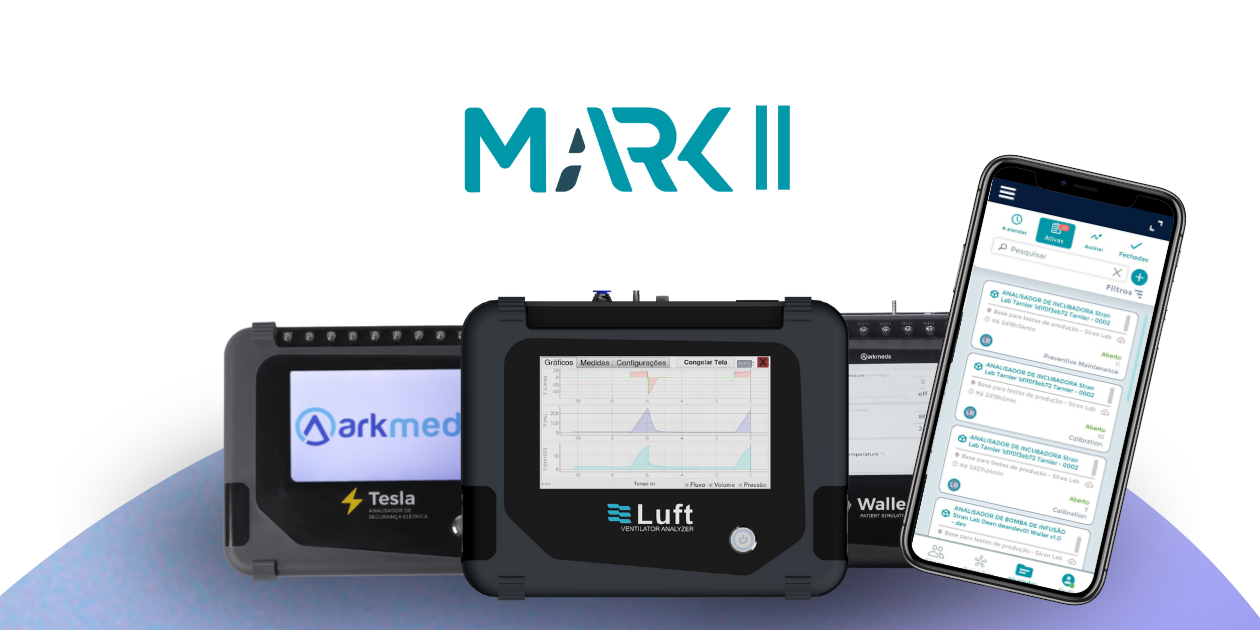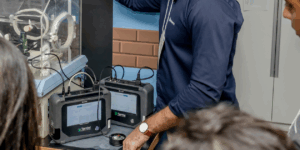Clinical engineering is going through one of the biggest revolutions in its history. If before technical work was marked by manual processes, endless paperwork and hours spent on operational tasks, today a new era is beginning to take hold of hospitals and hospital maintenance companies: the era of automation, artificial intelligence and intelligent asset management.
In this article, we’ll show you how Arkmeds technology, especially Mark II, is paving this new path. We’ll explain how the integration between analyzers, app and AI enables concrete gains in productivity, quality and safety, radically changing the way technical teams operate.
Get ready to get to know this transformation in depth. 🚀
What it was before: manual processes and risk of errors
For decades, the clinical engineering routine in hospitals and clinics was based on completely manual processes:
- Carry out electrical safety tests or calibrations, writing down the data by hand.
- Filling out work orders manually, item by item.
- Typing up certificates and reports in text editing software.
- Controlling inventories and maintenance histories with spreadsheets (often out of date).
- Keep physical copies on file for inspections and audits.
In addition to being time-consuming, this model was extremely prone to human error, from typos to lost documents and difficult tracking.
It was against this backdrop that the need for transformation arose.
The arrival of Mark II: integration, automation and intelligence
Developed by Arkmeds, Mark II is much more than an application. It is the bridge between the physical analyzer (hardware) and intelligent clinical engineering management (software + data).
Its main differentials include:
- Full integration: connects via Bluetooth with all Arkmeds analyzers.
- Process automation: generates reports, reports, work orders and certificates automatically.
- Customization: checklists and calibration templates can be customized according to standards, technical manuals or internal procedures.
- Digital traceability: complete history of each piece of equipment, accessible at a touch via QR Code.
- Working offline: even without internet, the system collects and organizes data.
- Multiple digital signatures: speeds up internal approvals and delivery of results to the client.
- Applied Artificial Intelligence: interprets data in real time, suggests fill-ins, organizes workflows and alerts you to inconsistencies.
With this, the Mark II transforms the technical routine into something faster, safer and much more efficient.
Understanding how integration works: a practical example
Imagine you need to calibrate a lung ventilator.
In the traditional model:
- Print out a checklist.
- Carry out measurements manually.
- Write down all the values by hand.
- Then type this information into a document.
- Review all the material to validate that the data has been copied correctly.
Now with the Mark II:
- Open the app on your phone or tablet.
- Scan the device’s QR Code.
- The app automatically connects to the analyzer via Bluetooth.
- The readings are recorded and filled in on the report in real time.
- At the end, it generates the certificate automatically, ready for digital signature.
The result? A reduction of up to 70% in execution time, as well as full data traceability and compliance with technical standards.
The impact of Artificial Intelligence
The great thing about the Mark II is that it doesn’t just automate tasks, it learns from them.
The system’s Artificial Intelligence:
- Detects data inconsistencies (e.g. non-standard values).
- Generates proactive alerts to review procedures.
As a result, the app not only makes work easier, it acts as an intelligent assistant, supporting engineers in their decision-making.
Equipment history and QR Code: traceability that generates trust
With Mark II integration, each device receives a unique QR Code. By scanning this code:
- The engineer has immediate access to the equipment’s life sheet.
- View all preventive and corrective maintenance already carried out.
- Tracks calibration results and electrical safety tests.
- Generates complete reports for audits in a few seconds.
This automatic traceability eliminates the risk of information loss and facilitates critical processes such as hospital audits, international accreditations (ONA, JCI) and health surveillance inspections.
With a single click, the history of the equipment is revealed, without papers, without physical folders, without errors.
Digital and Multiple Signatures: more agility, more security
The digital transformation would not be complete without a robust digital signature system.
In Mark II:
- Engineers can electronically sign reports and OS directly from the app.
- Clients (hospitals or clinics) can also sign their reports remotely.
- If necessary, multiple chain subscriptions are supported (e.g. technician + manager + customer).
That guarantees it:
- Quick validation of documents, without the need to print them out or send them physically.
- Data integrity, with protection against subsequent changes.
- Time-saving, audit-ready reports in minutes.
In a world that demands efficiency and legal security, digital signatures are not just an advantage, they are a necessity.
Real cases: where we are already transforming routines
In hospitals, clinics and technical companies that have already implemented Mark II and Arkmeds automation, the impacts have been immediate:
Reduction of up to 70% in maintenance and calibration time.
Reduction of typing errors in reports and certificates.
Agility in delivering results to the end customer.
Significant improvement in internal and external audit indices.
Increased auditor confidence during inspections.
More productive technical engineers focused on strategic tasks.
In other words, digital transformation is not just a concept , it’s a practical reality.
Why does it matter? More productivity, more quality, more recognition
With an automated routine:
- You reduce operating time.
- You gain more time for planning and strategy.
- Increase your productivity without having to increase your team.
- Improve your financial results.
- And above all: it strengthens patient safety, which is the ultimate purpose of clinical engineering.
Hospitals and providers that adopt these technologies are positioning themselves as benchmarks for efficiency and quality in the healthcare market.
Changing Organizational Culture: the biggest challenge (and the biggest opportunity)
Adopting the Mark II and all of Arkmeds’ integrated intelligence is not just a change of tools, it’s a change of mentality.
It means understanding that:
- Clinical engineering can be a center for strategy, not just execution.
- Technology is an ally for improving results – not an obstacle.
- Well-processed information is a hospital’s most valuable asset.
When teams embrace this transformation, growth is inevitable.
Companies and hospitals that can see this today will be the market leaders of tomorrow.
The Future of Clinical Engineering: Intelligence, Agility and Security
To look forward is to realize that:
- Hospital asset management will become increasingly digital.
- Artificial intelligence will support, not replace, clinical engineering professionals.
- Complete traceability will be a basic requirement in audits and certifications.
- Hospitals and providers that don’t adapt will simply be left behind.
The Mark II is the tool that connects the present with the future.
And Arkmeds is here to build that future with you.
Transform your daily life with the right technology
If you’re tired of the same slow processes, the same manual errors and the same old challenges…
It’s time to evolve.
With the Mark II and all the Arkmeds technology, you win:
- Agility
- Precision
- Control
- Visibility
- And a new leading position in clinical engineering
It’s no longer about putting out fires.
It’s about building, planning and growing.
Transformation is within your reach.
Enter the new era of clinical engineering with Arkmeds, see how Mark || can revolutionize your maintenance, go here



